Remove Lezp Ransomware (.lezp Decryption)
Lezp ransomware is a kind of crypto-virus that encrypts valuable files and demands ransom payment from the victims in exchange for the decryption tool. Typically, Lezp ransomware spread through computers via spam emails, infected websites, or malware advertising. For instance, when web user opens a malicious attachment from an unfamiliar or suspicious email message, it might activate or install the Lezp ransomware onto the computer. Similarly, when web user is visiting dubious websites running contaminated advertisements, it can possibly install the Lezp ransomware and immediate infects the system.
As soon as Lezp is activated on the computer, it begins encrypting valuable files of victim using a complex algorithm. All infected files will become inaccessible and victims cannot open them until the ransom fee is settled. Aside from that, all data infected by Lezp ransomware are renamed by adding .lezp file extension. Right after the encryption process, the Lezp ransomware will create a ransom note for victims within the text file _readme.txt. It contains the message of Lezp developers to the victims informing them of the situation along with the detailed instructions regarding the methods of payment.
Just like any other ransomware, Lezp developers will instruct the victims to pay the ransom fee in Bitcoin currency. Most of the ransomware developers prefer to transact via crypto-currency because it is somehow untraceable. The cost of the ransom fee may range from $490 to $980 depending on how long it will take victims to contact the attacker. The discounted amount of $490 may increase over time.

If the computer user encounters Lezp or any other ransomware, it is not advisable to negotiate further with the attackers. Ransomware developers are deemed as cyber-criminals and should not be trusted in any way. Rather than paying the ransom fee, it is better to focus on removing the Lezp or any ransomware installed on the computer as soon as possible.
How to Remove Lezp Ransomware
Ransomware files are placed deeply into the system and on various locations, thus, thorough scanning is vital to totally remove Lezp virus. Aside from our suggested tool, you may also run your own security program.
Though affected files may be impossible to decrypt due to complexity of the encryption, you can still try recovery method like alternative tool, Shadow Explorer or Previous Version as described below.
Stage 1: Scan the Computer with Anti-Malware Tool
1. Download free anti-malware scanner called MalwareBytes Anti-Malware.
Malwarebytes Anti-Malware Download Link (this will open a new window)
2. After downloading, install the program. It may run automatically or you have to double-click on the downloaded file MBSetup.exe.
3. Carry out the installation with default setup process.
4. After the installation process, click the Get Started button to launch the program.
5. Continue with the prompts until the main program opens.
6. On the main console, click on Scan to run most complete detection method to find hidden objects associated to Lezp ransomware.
7. Scanning may take a while. Please wait until the anti-malware tool is done with the checking.
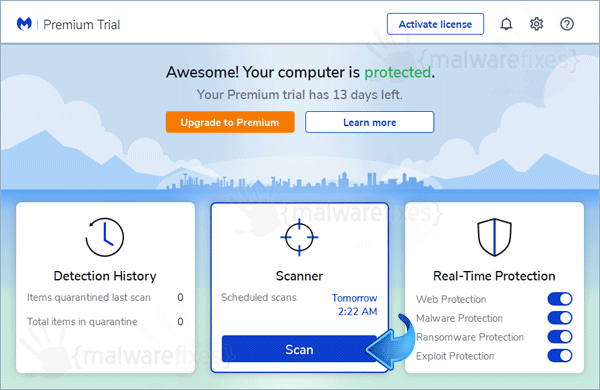
8. Once the scan has completed, the tool will display the list of detected threats. Remove all identified malicious items and restart the computer if necessary.
Stage 2: Double-check for Lezp’s leftover with Microsoft’s Malicious Software Removal Tool
1. Download the free scanner called Malicious Software Removal Tool.
Malicious Software Removal Tool Download Link (this will open a new window)
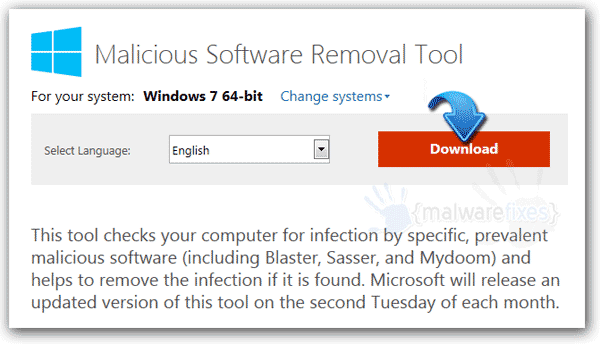
2. The tool automatically checks the operating system and suggest appropriate download version. Click on Download button to begin. Save the file to a convenient location, preferably on Desktop.
3. After downloading the file, Windows will prompt that download has completed. Click Run to start scanning for Lezp ransomware. Another option is to browse the location folder and double click on the file to run.
![]()
4. The tool will display Welcome screen, click Next. Please note the message “This tool is not a replacement for an antivirus product.” You must understand that this program is made specifically to find and remove malware, viruses, Trojans, and other harmful elements on the computer. It was not designed to protect the computer.
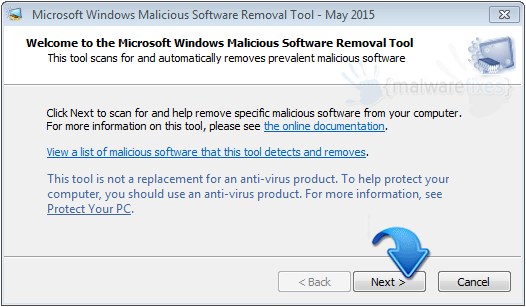
5. Next, you will see Scan Type. Please choose Full Scan to ensure that all Lezp ransom virus entities and other harmful files left on the computer will be found and removed. For advanced computer user, you can opt for Customized Scan, if there are other drives or folders you wanted to include in this scan.
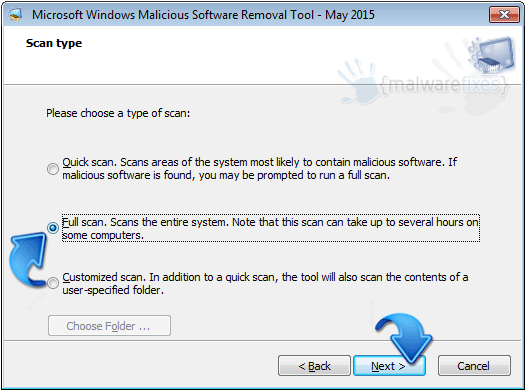
6. Full scan may take a while, please wait for Malicious Software Removal Tool to complete the tasks. However, you may cancel the scan anytime by clicking on the Cancel button.
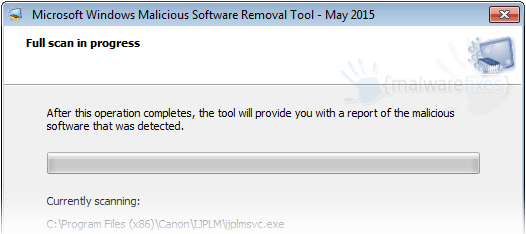
7. After scanning, the tool will reveal all identified threats. There may be other threats that our first scan fails to detect. Please remove/delete all detected items.
8. When removal procedure is complete, you may now close Malicious Software Removal Tool. We hope that Lezp ransomware have been completely deleted from the computer. Please restart Windows to proceed with the normal operation.
Stage 3 : Unlocking files with Lezp Decryption Tool
Emsisoft Decryptor for STOP Djvu will work only if affected files were encrypted using Offline Keys. Lezp ransomware uses the alternate Offline Keys during encryption if there is a problem encountered while communicating to a remote command-and-control server. Follow the guide to start recovering .lezp encrypted files.
1. As precautionary measures, we suggest to BACKUP all your .lezp encrypted files first on a separate media (USB Drive, Flash Drive, DVD Discs, etc…).
2. Download Emsisoft Decryptor for STOP Djvu from this archive page.
3. Right-click on decrypt_STOPDjvu.exe and click “Run as Administrator“. Windows may prompt “Do you want to allow this app…” just click Yes to continue.
4. By default, the tool will pre-populate the locations where encrypted files were identified. To include other directories, simply click Add Folder button.
5. To start recovering files infected by Lezp ransomware, click on Decrypt button to start the procedure. The interface will display status of the current decryption process.
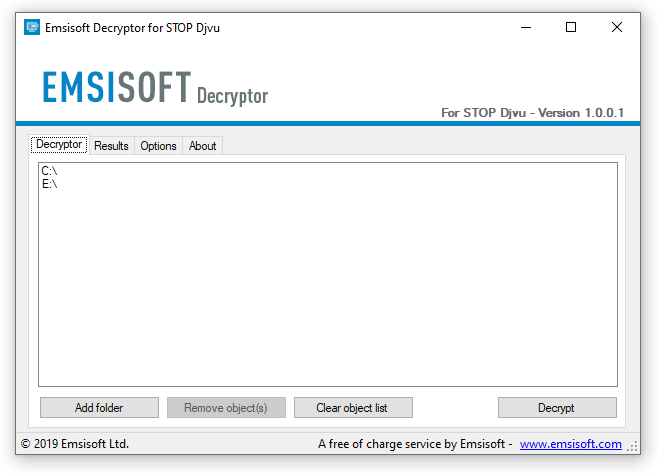
We will update this section once the full decryption tool is on hand. In the meantime, please try other options below if the above procedure is not not effective.
Option 1: Windows Previous Version Tool
Windows Vista and Windows 7 have a feature called Previous Versions. However, this tool is only usable if restore point was made prior to Lezp ransomware infection. To use this tool and recover files affected by the virus, please follow these steps:
1. Open My Computer or Windows Explorer.
2. Right-click on the affected files or folders. From the drop-down list, please click on Restore previous versions.
3. New window will open display all backup copy of files and folders you wanted to recover. Choose the appropriate file and click on Open, Copy, or Restore. Restoring selected files overwrites the current encrypted files on the computer.
Option 2: Use ShadowExplorer to restore files encrypted by Lezp Ransomware
Just like Previous Version tool, ShadowExplorer is taking advantage of shadow copy created by Windows. This tool allows you to retrieve older version of files before it was encrypted by Lezp ransomware.
1. Download ShadowExplorer from the official web site.
2. Install the program with the default settings.
3. The program should run automatically after installation. If not, double-click on ShadowExplorer icon.
4. You can see the drop-down list on top of the console. Please select proper drive and the most recent point-in-time shadow copies of files you wish to restore prior to Lezp ransomware infection.
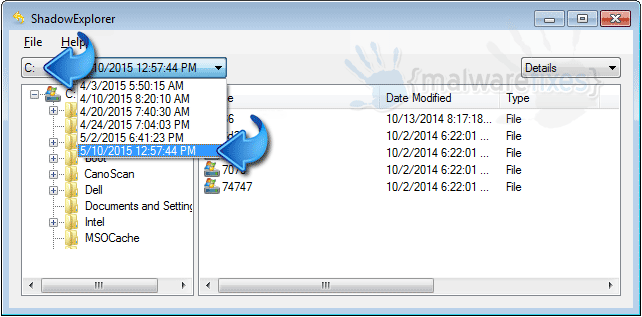
5. Right-click on the Drive, Folder, or File you wish to restore and click Export…
6. Lastly, ShadowExplorer will prompt for location where you want to save the copy of recovered files.








